The Orion Nebula gets a lot of attention from observers and rightly so, but we sometimes pass by a host of other deep-sky objects and double stars right at its doorstep.
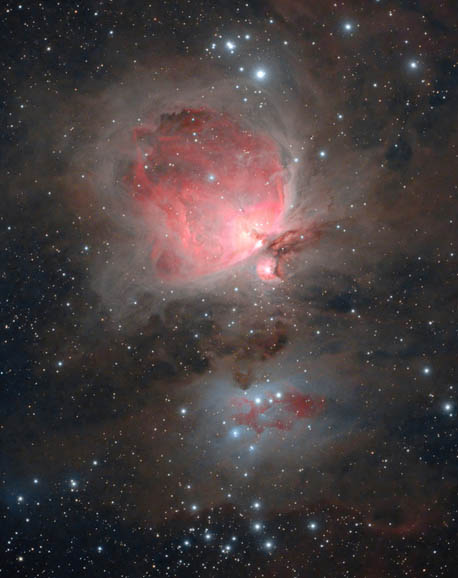
Hunter Wilson
The Orion Nebula is one of the most magnificent objects in the night sky. Like a masterful painting, it repays repeated observation with new details and insights.
Every winter season, I look again and again at its wispy tendrils, the textured darkness of the Fish's Mouth where it bites into the brilliant Trapezium region and seek the faint stars embedded within the glowing cloud's nooks and crannies.
Then I move on. But wait a second. There's a lot more to look at in the neighborhood besides "the big attraction." Within the 1.5° vertical strip of sky that includes the Orion Nebula, two star clusters, four emission-reflection nebulae, and four double or multiple stars shoot their hands in the air for attention like kids in the back of the room. Together, the lot of them make for a satisfying hour of observing on a mid-winter evening.
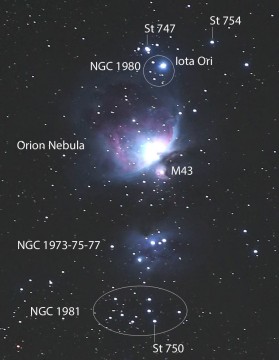
Bob King
Let's start with M43. Although it bears a separate "M" number, this pretty, comma-shaped nebula rightly belongs to the Great Nebula, separated from it by a narrow channel of dark nebulosity to the south. Its form reminds me of an ammonite, the ancient, extinct mollusk of dinosaur days.
At its center, a bright 7th-magnitude star ionizes hydrogen gas and excites it to glow a rich pink in photographs. Visually it's a grayish haze in my 10-inch Dob with a prominent indentation along its eastern border shaped by an intruding dark nebula.
If you increase the magnification to 100x or higher, you'll see a darker "bar" cutting approximately east-west across M43's northern half and a small, dark vacuity immediately west of the the central star. Both are subtle examples of yet more dark nebulae — gas clouds seen in silhouette against the brighter nebulae — that riddle the Orion Nebula region.
One or two faint additional stars hide within M43's confines; to see more you'll need dust-penetrating infrared eyes like NASA's WISE probe, which uncovered dozens of newborn stars otherwise hidden from sight.
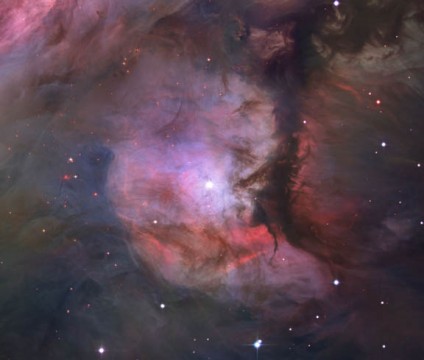
NASA / ESA / M. Robberto
While you're out with the telescope, pack a pair of binoculars, too. Even in 10x50s the Orion Nebula's flower-like shape is obvious on a moonless night. Study M43 closely. It might look like a star at first glance but a minute or two of close scrutiny will reveal it's smudgy with nebulosity. A half degree north of the M42-43 complex look for the bright duo of 42 and 45 Orionis, magnitudes 5.2 and 4.6 respectively. Under rural skies I can just make out some of the milky haze comprising the nebular trifecta of NGC 1977-1975-1973 using averted vision. We'll return to it in a moment.
Half a degree further north, you can't miss a bright jangle of stars known as NGC 1981. This loose gem of a cluster about 30′ wide was made for binocular observers. Some liken its shape to an alligator or crocodile seen from above with the easternmost star as the snout, the westernmost the tail and the two groups of three stars in the middle two sets of legs. Take a look, it won't bite. When I saw NGC 1981 for the first time, it looked like the letter "F" tipped on its side. These days I prefer the crocodile image.
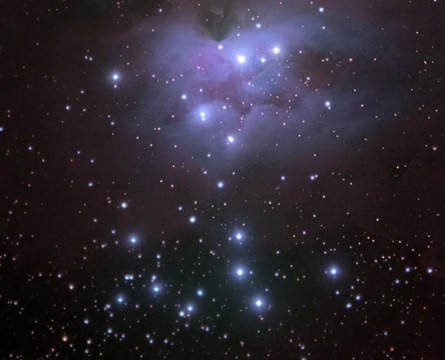
Jim Thommes
Ready for a little duplicity? We return to the telescope for a look at the close pair, Struve 750, located at the north end of the arc of bright stars in the crocodile's front legs. I can just split this attractive, unequal pair (magnitudes +6.5 and +8.5, separation 4.2″ in PA 60°) at 64x in my 15-inch; 115x does a better job while still preserving a crisp image.
Maybe you're like me and have taken "quick hits" at the emission-reflection nebulae complex NGC 1973-1975-1977. At a casual glance, the region looks like an amorphous haze surrounding 42 and 45 Orionis. Take a closer look and you'll tease out three separate islands of nebular light with streams and pools of dark nebulae sloshing about between.
The easiest and largest of the three surrounds a trio of bright stars in the north (42 and 45 Orionis and +7.3 magnitude HD 37058). Although the glare from the stars can be a little overwhelming, use averted vision and low magnification to look for a thick, 25′ long nebulous streak centered on and extending west of the trio.
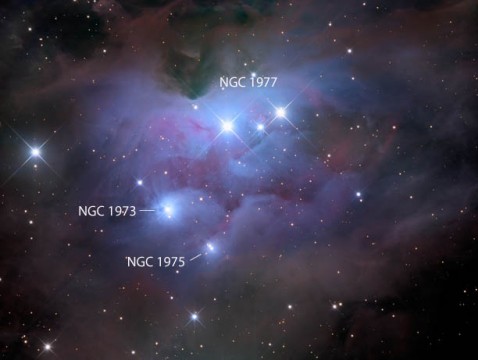
Martin Pugh
Only 8′ northwest of NGC 1977, NGC 1973 appears as a puff of frosty haze centered on a pair of 7th- and 9th-magnitude stars. Don't stop just yet. Four arc minutes to the northeast, look for a fainter pair of stars at the center smaller, weaker patch of nebulosity — NGC 1975 — that resembles a small comet. Dark nebulae worming between their bright counterparts come and go with the vagaries of averted vision. Additionally, there's an obvious "indent" or bite just a few arc minutes north of 42 Orionis, the easternmost bright star in NGC 1977.
That indent is only the most obvious part of a much larger dark nebula filling the gulf between NGC 1977 and M43-42. Try averted vision to see it best. The entire region is "rich as Croesus" in dark and bright dust gobbled up by gravity to build a new generation of stars. You can almost see the process in action right before your eyes. Try a nebular filter on the complex; I found that an O III filter generally increased contrast and definition.
South of Orion's core, we follow a great "wing" or arc of nebulosity straight to 3rd magnitude Iota Orionis, one of the winter sky's finest triple stars and seat of the sparse star cluster-nebula NGC 1980. The primary is an O9 giant 14,000 times more luminous than the Sun with two visual companions: a 7th-magnitude secondary 11.3″ to the southeast (PA 141°) and a pale red 10th-magnitude tertiary 49″ further south and east. The primary is double again, but it's spectroscopic and not detectable visually.
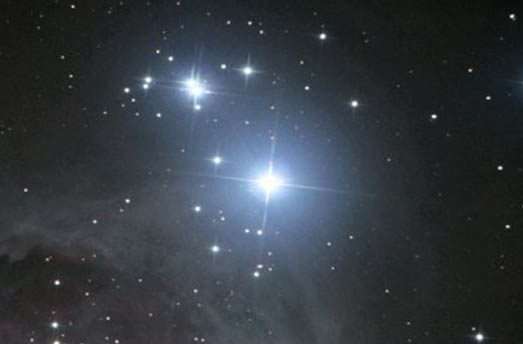
Tenho Tuomi
Iota glares from within a weak patch of nebulosity that forms part of the outer loop of the Orion Nebula and is attended by an arc of four 7th-to-9th-magnitude stars to the west along with a smattering of others. The whole works goes by NGC 1980. The cluster is sparse, but two additional doubles brighten the scene — the wide, low power pair, Struve 747 (magnitudes +4.8 and +5.7, separation 36″ in PA 223°), 7′ to the southwest and the close, unequal Struve 754 (magnitudes +5.7 and +8.9, separation 5.2″ in PA 287°) 20′ east of Iota. Including Iota, this tiny slip of sky boasts three easy multiple stars for any telescope.
Since all 10 objects cross the meridian around 8 o'clock p.m. local time in mid-February, their linear arrangement makes it easy to start at either the north or south end of the group and navigate to the other with a simple downward pull or upward push of the telescope.
Next time it's clear, put M42 in the backseat and pay a visit to its humble neighbors.
 0
0








Comments
You must be logged in to post a comment.